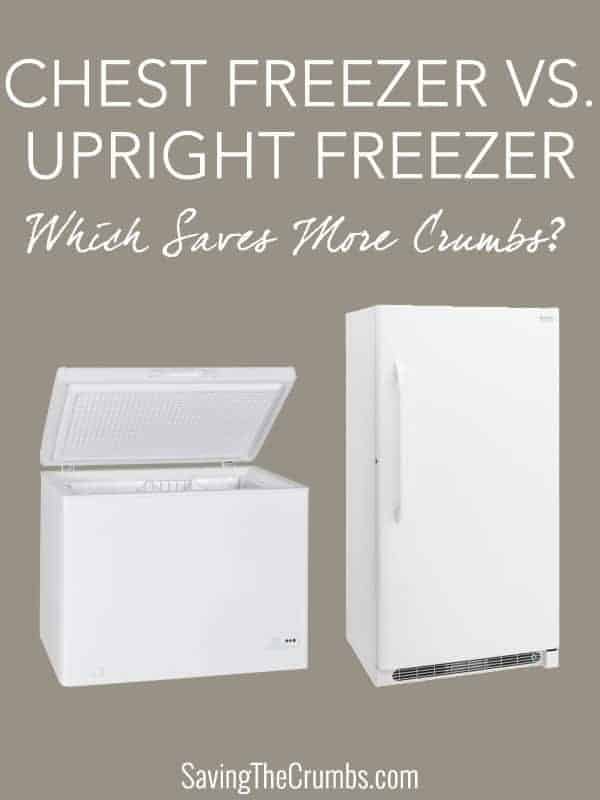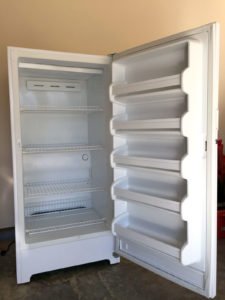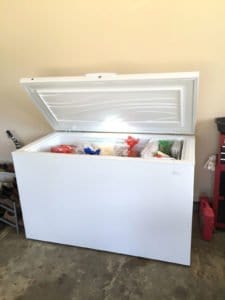For the year or two previously, we were actually using an old 10 cubic feet upright freezer that we bought for $150 on Craigslist. We were maxing it out, needed more space (to freeze baby food), and figured that we could get some energy savings to boot. So since we paid off the house last August, and we were employing the art of having our cake and eating it too, we decided this past Christmas that it was time to make the upgrade.
Now since you’re wondering how many crumbs this allows us to save, I’m going to break it all down in this post to give you more details than you ever cared to know. 🙂
Why A Freezer At All?
A freezer is one of those appliances that’s plugged in 24-7, everyday, all the time. So with this ongoing draw of electricity, why own an extra freezer besides the refrigerator at all?
Of course, the reason is because a freezer is our first line of defense in preserving food for later consumption. We’re still eating pesto, sweet peppers, and green beans from our garden from two years ago! Moreover, it gives you space to stock up on food that’s on steep discount too. (Frozen bananas for smoothies, anyone?) The freezer is an essential tool in our arsenal to keep our food budget to the minimum.
However, I hasten to add that freezers offer no savings at all if we use them to stockpile food that we never eat and that we throw away because it’s too freezer burnt or old-looking! So don’t use freezers as an excuse to hoard stuff or let stuff go to waste!
Chest or Upright? Pros and Cons
Freezers come in two configurations, the chest and the upright. So which one is better? Here are some of the pros and cons that we thought of.
| Pros | Cons | |
| Chest Freezer |
|
|
| Upright Freezer |
|
|
I’m sure there are other variables to consider that I’m forgetting, so feel free to share in the comments any that I’ve missed!
Burned By The Freezer: Cost of Operations
So you know that when we count up the crumbs, we take into account not just the purchase price of the unit, but the total cost of ownership. So naturally, that’s exactly what we did in deciding whether to upgrade to another upright or to move to a chest configuration.
We did some hypothetical comparisons using the numbers provided by the manufacturer prior to our purchase, which led to a clear winner. But in this post, we don’t need to use hypotheticals because using my handy-dandy electricity meter, I measured the exact energy usage of both units and can show you the comparison in this table below.
Before we get into it, here are some photos of our two contestants in this prizefight.
The old upright.
The new chest freezer.
A few pieces of details to keep in mind:
- Upright Freezer: Frigidaire brand, 10 cubic feet. We didn’t know the exact age, but estimated that it was probably around 15 years old.
- Chest Freezer: Frigidaire brand, 15.6 cubic feet. Brand new.
- Cost of electricity per kWh: The rate in our area stays pretty consistent around $0.10.
- Measurements were taken on days of similar temperature in the spring under similar usage.
- Both freezers operated in the exact same location in our garage.
| Upright Freezer | Chest Freezer | |
| kWh used per day |
2.03 |
0.569 |
| Cost per day |
$0.20 |
$0.06 |
| kWh used per year |
742.3 |
207.7 |
| Cost per year |
$74.09 |
$20.73 |
These figures reflect projections based on only one day of measurements. So with varying temperatures throughout the year, the exact figures will be different. However, these numbers are able to show the difference of efficiency and cost between the two units.
As you can see, the chest freezer is over THREE TIMES more energy efficient than the upright*, and is 50% bigger to boot! With savings like these, whatever downsides came along with chest freezers seemed rather insignificant to us. (Honestly though, after using the chest freezer for a while, we haven’t found organizing or accessing stuff inside to be as bad as we had feared.) Of course newer uprights would be more efficient since the one we had was quite old and made before some newer regulations came on the scene. However, neither units were Energy Star certified, as the increased price of an Energy Star freezer didn’t really seem to result in that significant of additional savings.
Saving On the Purchase
So once we determined that a chest freezer was definitely the best way to go for long-term energy savings, we needed to make sure that we got a good deal on the actual purchase.
One of the things we were really looking for was free (or cheap) delivery since we didn’t own a minivan, truck, or other large vehicle to pick up a large freezer, and also because we were still suffering somewhat from the delirium of having a new baby in the house. We did do some hunting on Craigslist since sometimes the sellers are willing to deliver, but we were shocked that during the few weeks of our research, there were hardly any decent chest freezers. I guess chest freezers are so great that no one wanted to sell theirs!
Finally, we happened across a big sale on new freezers at Home Depot. The Frigidaire 15.6 cubic feet chest freezer we ended up getting normally retailed for $600. The sale price was $398! And of course it also came with free delivery.
But that’s not all, we also used a gift card purchased at a 6% discount from Cardpool, which was paid for with our 2% cash back credit card. So the final cost looked something like this:
| Sale Price |
$398.00 |
| Tax 9.25% |
$36.82 |
| Sale Total |
$434.82 |
| Cardpool 6% |
-$26.09 |
| Credit Card 2% |
-$8.17 |
| Final Total |
$400.56 |
So the additional discounts and cash back nearly wiped out my sales tax on the purchase. (9.25% is no chump change!) So in the end, we got the freezer for $235 off of the original list price of the unit, delivered.
Then There’s the Old Freezer
Of course we didn’t just throw away the old upright that we just upgraded from, but we listed it for sale on Craigslist. We had it sold within a day. And get this—we sold it for $170! Twenty bucks more than what we paid for it over a year earlier!
So if we subtract the extra $20 we earned from the sale, the new freezer only cost us $380.
The Final Tally: Total Cost of Ownership
In the final comparison of total cost of ownership (TCO) between the two, you can see below that within 5 years, we will be saving more with the chest freezer compared to the upright. And this doesn’t even take into account the benefit of the additional freezer space that we have access to, which may increase our savings in other areas of our budget.
|
Upright Freezer |
Chest Freezer |
|
| Cost of Unit |
$150 |
$380 |
| Year 1 TCO |
$150+74 = $224 |
$380+20 = $400 |
| Year 2 TCO |
$224+74 = $298 |
$400+20 = $420 |
| Year 3 TCO |
$298+74 = $372 |
$420+20 = $440 |
| Year 4 TCO |
$372+74 = $446 |
$440+20 = $460 |
| Year 5 TCO |
$446+74 = $520 |
$460+20 = $480 |
Taking these numbers one step further, even if we got the upright freezer for FREE, we would STILL be saving more with the chest freezer after a little more than 7 years! (Run the numbers. The free upright will have cost around $518 just in electricity by year 7 while the chest freezer’s TCO including the price of purchase would be $520.)
I hope this example from our experience with this purchase has been instructive on the importance of taking into account all of the costs involved in owning a product. The sticker price is only the tip of the iceberg! Freezers don’t have many additional costs besides the purchase and electricity, but that’s not true for many other items. Besides the cost of the purchase, there may also be costs for operating, maintaining, registering, licensing, insuring, repairing, cleaning, customizing, transporting, storing, winterizing, detailing, manicuring, training—you get the idea!
So don’t get burned by your freezer, or anything else you own for that matter!
*Now WHY are chest freezers so much more efficient than uprights? It has to do with the fact that cold air is heavier than warm air. So whenever we open the door on an upright freezer, all the cold air whooshes out (you know that cool sensation on your bare feet?) and the compressor has to run to cool everything down again whereas in a chest freezer, the coldest air stays put even when the lid is open at the top meaning the compressor has to work less. On a somewhat related and counter-intuitive note, a full freezer is more efficient than an empty one. The reason is because the frozen stuff in the freezer helps stabilize the temperature by reducing airflow and through thermal mass so the compressor needs to run less to maintain a low temperature. Some people keep bottles of frozen water in their freezer for this reason. Oh yeah, and this principle holds true for refrigerators too. See? I told you I’m sharing more details about freezers than you cared to know!









